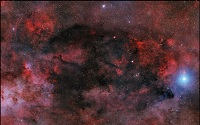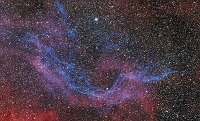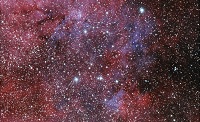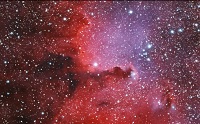




Coalsack Nebula
Theta Musca Nebula
WX Centauri Nebula
RCW 75
Jewel Box
[back] Constellation Crux with Coalsack Loop / Kreuz des Südens mit Kohlensackschleife
(c) 2023 All astro photo images are copyrighted. They may not be used or reproduced without explicit written permission from the authors.
Please use next|prev (upper
right) to switch between Hubble pallete, annotated Hubble palette, annotated
HSO, HSO (quasi RGB)
versions of the image.
Bitte verwenden Sie next|prev (oben rechts) um zwischen
Hubble Palette, beschrifteter Hubble-Palette, beschriftetem HSO (quasi
RGB) und HSO (quasi RGB) umzuschalten.
Click on one of the images below to bring up some highlights
in the image above (you may need the right scroll bar to scroll up)
Klick auf eines der Bilder unten zeigt einige Highleights im Bild oben
(ggf. benutzen Sie die Bildlaufleiste rechts, um nach oben zu scrollen
|
|
|
|
|
|
|
Coalsack Nebula |
Theta Musca Nebula |
WX Centauri Nebula |
RCW 75 |
Jewel Box |
|
|
|
|
|
|
|
RCW 69 |
SNR G299.2-02.9 |
RCW 76 |
SuWt 2 |
VBRC 5 |
About this Image / Über dieses Bild
| Camera: | Moravian C3-PRO-61000 Mono CMOS |
| Image Type, Orientation: | SII,Ha,OIII False Color and/or Ha,SII,OIII near real color 4x4 Mosaik, North is ~ 12:00 for the middle of the image |
| Exposure time: | SII: 60x300sec., Ha: 30x300 sec., OIII: 60x300 sec. (12:30h) for each panel, 200h(!) total |
| Exposure date: | June 5th ... August 9th, 2023 |
| Location: | Capella Observatory South at Kiripotib Astro Farm, Namibia |
| Filter: | Astronomik 6nm SII, Ha, OIII filters on Moravian EFW-3L-9-II External Filter Wheel |
| Instrument: | "Callisto", a Takahashi FSQ 106N, 530mm focal length, 106mm aperture, f/5 on modified Losmandy G11 (high res encoders with OnStepX) |
| Photographer: | Rainer Raupach, Josef Pöpsel, Frank Sackenheim |
| Remarks: |
After Capella Observatory South hardware was
completed in May 2023, the system was set to show how it performs. Image
destination was the area around the iconic Southern Cross with Jewel Box and
Coalsack Nebula. It was known since the mid 1990's that around the
Southern Cross and the Coalsack Nebula a huge ring glowing in Ha
exists,
which we wanted to image (see
here
and
here). We decided to expose the area not only in Ha but mainly in OIII
and SII. Despite the full-frame chip and a focal length of only 530mm, a 4x4
mosaic was necessary to completely depict the selected target. In the end we
invested 12 ½ hours per tile of the mosaic, 5 hours each OIII and SII, and 2
½ hours Ha. All in all this resulted in 200 hours of exposure time, which we
were able to work through within two months thanks to the “always best”
conditions in Namibia. Five minutes unguided sub exposures were used. Controlled by a sequence in N.I.N.A. the exposures were mostly made automatically, but with several hours of “babysitting”. The result is a 0.7 gigapixel image (31271 x 22169 pixels) with an original pixel scale of 1.464''/pixel (reduced to 1.78"/pixel (85%) due to memory limitation generating the mosaic with APP). This high resolution allows to show even small details such as a lot of tiny PNs. Whether the coal sack loop is a supernova remnant or not has not been conclusively determined, but it is assumed. Also not confirmed as a SNR is the pretzel-shaped OIII structure at the bottom of the image. The future will show whether it is the visible part of SNR G304.4-3.1 or an OIII cloud emitted by the WR star Theta Muscae (see also here). In order to match SII, Ha and OIII exactly in the overall image (mosaic), an "RGB image" with SII,Ha,OIII registered on top of each other was created after stacking the individual images per panel. Subsequently, these "color images" were combined in Astro Pixel Processor to form an overall image, from which the SII,Ha,OIII channels were extracted again and further processed individually.
The image of the moon superimposed in the upper left
corner (labeled versions only) makes it clear how large the displayed
section of sky is. |
|
|
|
| Bemerkungen: |
Nachdem die Hardware des Capella Observatory South im Mai 2023 fertiggestellt war, sollte das System zeigen, was es konnte. Ziel war das Gebiet rund um das ikonische Kreuz des Südens mit Schmuckkästchen und Kohlensacknebel. Seit Mitte der 1990 war bekannt, dass rund um das Kreuz des Südens und den Kohlensacknebel ein riesiger in Ha leuchtender Ring zu finden war, den wir abbilden wollten (siehe hier und hier). Wir beschlossen, die Gegend nicht nur in Ha sondern hauptsächlich in OIII und SII zu belichten. Trotz Vollformat-Chip und nur 530mm Brennweite war ein 4x4 Mosaik nötig, um das ausgewählte Ziel komplett abzubilden. Letztlich haben wir pro Kachel des Mosaiks 12 ½ Stunden investiert, jeweils 5 Stunden OIII und SII, und 2 ½ Stunden Ha. Insgesamt macht das 200 Stunden Belichtungszeit, die wir aber dank der „immer besten“ Bedingungen in Namibia innerhalb von zwei Monaten abarbeiten konnten. Belichtet wurden jeweils fünf Minuten ungeguided. Gesteuert durch eine Sequenz in N.I.N.A. entstanden die Aufnahmen großteils automatisch, aber mit diversen Stunden „Babysitten“. Das Ergebnis ist ein Bild mit 0.7 Gigapixel (31271 x 22169 Pixel) mit einem ursprünglichen Pixelscale von 1.464''/Pixel, der auf Grund von Speicherplatzbeschränkungen bei Verwendung von APP auf 1.78" (ca. 85%) reduziert wurde. Diese hohe Auflösung erlaubt es, auch kleine Details wie z.B. eine Menge winziger PNs zu zeigen. Ob der Kohlensack-Ring ein Supernova-Überrest ist, oder nicht, ist nicht abschließend geklärt, man geht aber davon aus. Ebenfalls nicht als SNR bestätigt ist die Brezelförmige OIII-Struktur am unteren Rand des Bildes. Ob es nun der sichtbare Teil von SNR G304.4-3.1 oder eine vom WR-Stern Theta Muscae abgestrahle OIII-Wolke ist, wird die Zukunft zeigen (siehe auch hier). Um SII, Ha und OIII im Gesamtbild (Mosaik) exakt zur Deckung zu bringen, wurden nach dem Stacken der Einzelbilder pro Panel ein „RGB-Bild“ mit aufeinander registrierten SII,Ha,OIII erstellt. Anschließend wurden diese „Farbbilder“ in Astro Pixel Prozessor zu einem Gesamtbild vereinigt, aus dem dann die SII,Ha,OIII Kanäle wieder extrahiert und einzeln weiterverarbeitet wurden. Das im Bild eingeblendete Bild des Mond in der oberen linken Ecke (nur beschrifteten Versionen) macht deutlich, wie groß der dargestelle Himmelsauschnitt ist. Das Bild wurde mit dem BlurrXTerminator bearbeitet, wobei lediglich "correct only" verwendet wurde. |
Back to the "Star-Fields" Overview / Zurück zur "Sternfelder"-Üersichtsseite